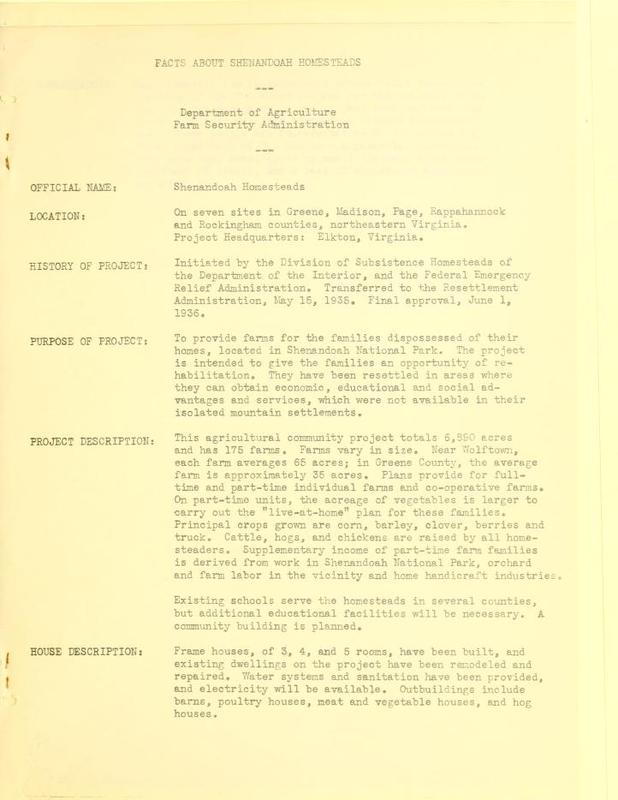Facts about Shenandoah Homesteads
Title
Facts about Shenandoah Homesteads
Subject
subsistence homesteads
Excerpt
Initiated by the Division of Subsistence Homesteads of the Department of the Interior, and the Federal Emergency Relief Administration, Transferred to the Resettlement Administration, May 15, 1935.Final approval, June 1,
1936.
PURPOSE OF PROJECT: provide farms for the families dispossessed of their homes, located in Shenandoah National Park. The project is intended to give the families an opportunity of rehabilitation. They have been resettled in areas where they can obtain economic, educational and social advantages and services, which were not available in their isolated mountain settlements.
PROJECT DESCRIPTION: This agricultural community project totals 6,390 acres and has 175 farms. Farms vary in size. Near Wolftown, each farm averages 65 acres; in Greene County, the average farm is approximately 35 acres. Plans provide for full-time and part-time individual farms and co-operative farms. On part-time units, the acreage of vegetables is larger to carry out the "live-at-home" plan for these families. Principal crops grown are corn, barley, clover, berries and truck. Cattle, hogs, and chickens are raised by all homesteaders. Supplementary income of part-time farm families is derived from work in Shenandoah National Park, orchard and farm labor in the vicinity and home handicraft industries.
1936.
PURPOSE OF PROJECT: provide farms for the families dispossessed of their homes, located in Shenandoah National Park. The project is intended to give the families an opportunity of rehabilitation. They have been resettled in areas where they can obtain economic, educational and social advantages and services, which were not available in their isolated mountain settlements.
PROJECT DESCRIPTION: This agricultural community project totals 6,390 acres and has 175 farms. Farms vary in size. Near Wolftown, each farm averages 65 acres; in Greene County, the average farm is approximately 35 acres. Plans provide for full-time and part-time individual farms and co-operative farms. On part-time units, the acreage of vegetables is larger to carry out the "live-at-home" plan for these families. Principal crops grown are corn, barley, clover, berries and truck. Cattle, hogs, and chickens are raised by all homesteaders. Supplementary income of part-time farm families is derived from work in Shenandoah National Park, orchard and farm labor in the vicinity and home handicraft industries.
Creator
Farm Security Administration
U.S. Department of Agriculture
Date
n.d.
File(s)
Facts about Shenandoah Homesteads 1.jpg
(image/jpeg)
Facts about Shenandoah Homesteads 2.jpg
(image/jpeg)
 An official website of the United States government.
An official website of the United States government.



